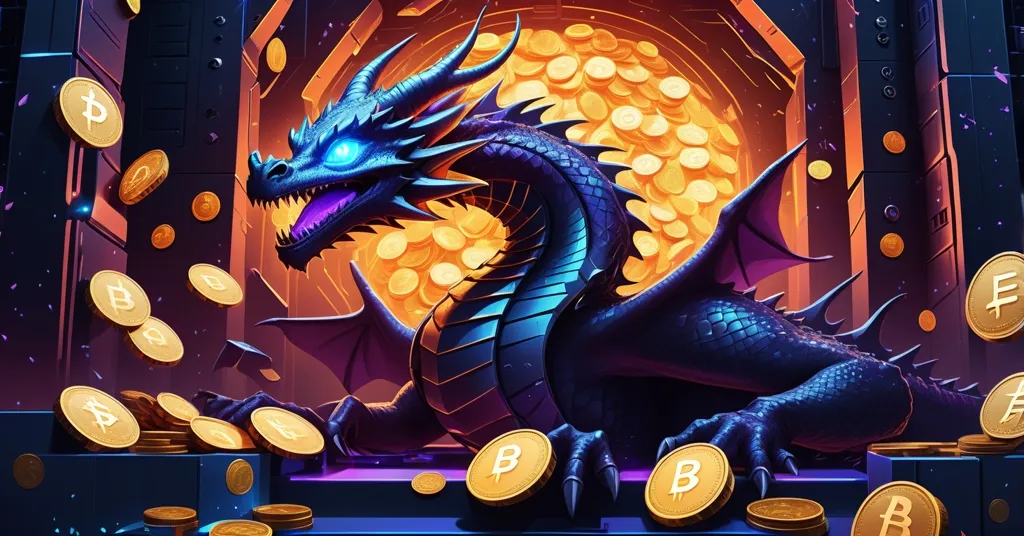SharpLink Gaming Raises $76.5M to Boost Ethereum Treasury Amid Crypto Surge

SharpLink Gaming’s $76.5M Raise: A Bold Ethereum Bet Amid Crypto Treasury Surge
SharpLink Gaming, a Minneapolis-based publicly-traded company, has just clinched a massive $76.5 million through a direct stock offering at a 12% premium above market rate, signaling strong institutional faith in its Ethereum (ETH)-centric treasury strategy. With plans to potentially acquire more ETH, this move underscores both the promise of decentralized finance and the high-stakes gamble of tying corporate value to volatile digital assets.
- Capital Boost: SharpLink raised $76.5M by selling 4.5M shares at $17 each, above market and NAV.
- Ethereum Powerhouse: Holding 840,124 ETH, it ranks second among public firms for ETH treasury size.
- Market Risks: Crypto treasury trend grows post-Trump’s 2024 win, but volatility and regulatory hurdles persist.
SharpLink’s $76.5M Power Play: A Premium Deal
On the surface, SharpLink’s latest financial maneuver is a textbook win. By selling 4.5 million shares at $17 each—a 12% premium over the market price of $15.5 (based on October 15 closing) and even above the Net Asset Value (NAV) of its holdings—the company has pulled off a rare feat. For those unfamiliar, NAV is a measure of a company’s total asset value minus liabilities, often used to determine if a stock is fairly priced. Selling above NAV screams confidence from institutional investors, who see SharpLink not just as a gaming firm but as a serious player in the blockchain space. Yet, the market’s immediate response was tepid, with shares dipping to $15.07 post-announcement. That said, let’s zoom out: SharpLink’s stock has soared 445% over the past six months, fueled largely by Ethereum’s price rally, currently sitting at $3,921 (down 1.7% in the last 24 hours). Numbers don’t lie, but they don’t tell the whole story either.
Co-CEO Joseph Chalom framed this raise as a strategic masterstroke, emphasizing its dual benefit to shareholders and the company’s crypto ambitions. If you’re curious about the specifics of this deal, check out the recent Ethereum investment raise by SharpLink for deeper insights.
“This is a novel equity sale transaction that is both accretive to stockholders and strategically structured, reflecting strong institutional confidence in SharpLink and our long-term vision. By raising equity at a meaningful premium to both market price and NAV, we’re able to continue accumulating ETH and increasing ETH-per-share for our investors.”
Translation for the newbies: this deal boosts value for shareholders while giving SharpLink the cash to stack more Ethereum. With 840,124 ETH already in its treasury—making it the second-largest publicly-traded holder behind BitMine Technologies, which hoards over 3 million ETH per Coingecko data—SharpLink’s digital stash is worth billions. That’s a hoard fit for a dragon in the decentralized realm, but will it breathe fire or get burned?
Why Ethereum? Unpacking the Blockchain Appeal
SharpLink’s obsession with Ethereum isn’t random. Unlike Bitcoin (BTC), often hailed as digital gold for its store-of-value appeal—a narrative near and dear to us Bitcoin maximalists—Ethereum powers a sprawling ecosystem. It’s the backbone of smart contracts (self-executing agreements coded on the blockchain that cut out middlemen), decentralized finance (DeFi, a system of financial apps running on blockchain without banks), stablecoins (cryptos pegged to stable assets like the US dollar), and tokenized assets (digital versions of real-world stuff like real estate or art). At Ethereum’s current price, SharpLink’s holdings represent a bet on a future where these use cases explode. Chalom himself doubled down on this vision.
On Ethereum adoption, he noted it “continues to grow among both retail and institutional investors, across different verticals such as stablecoins, decentralized finance (DeFi), and tokenized assets.”
For SharpLink, Ethereum isn’t just a currency; it’s a platform for innovation. With over $50 billion locked in DeFi protocols on Ethereum (based on recent DefiLlama data), the network’s utility is undeniable. Could SharpLink be eyeing staking their ETH for yield after the 2022 Merge to Proof-of-Stake, which made Ethereum more energy-efficient and allowed holders to earn rewards? Or perhaps dipping into DeFi projects or NFT ventures? While speculative, these possibilities highlight why ETH might be a strategic growth play over Bitcoin’s more conservative “hold and hedge” vibe. As maximalists, we might grumble, but Ethereum fills niches Bitcoin doesn’t—nor should it—touch.
The Crypto Treasury Wave: A Post-Trump Boom
SharpLink isn’t operating in a vacuum. The trend of corporate crypto treasuries—where firms hold digital assets as reserves instead of cash or bonds—has been gaining steam since MicroStrategy, led by Michael Saylor, started stacking Bitcoin in 2020 as an inflation shield. Fast forward to 2024, and Donald Trump’s US election victory on a pro-crypto platform has poured fuel on the fire. CEOs now feel emboldened to experiment, diversifying beyond Bitcoin and Ethereum into altcoins like Solana (SOL, known for lightning-fast transactions), Avalanche (AVAX, built for scalability), and even meme coins like Dogecoin (DOGE, often hyped by Elon Musk’s whims). For the uninitiated, altcoins are any cryptocurrencies besides Bitcoin, often tailored for specific purposes or communities. Dogecoin on a balance sheet might sound like a joke, but in this wild west of finance, it’s reality.
This shift isn’t just about hedging bets; it’s a middle finger to fiat dominance and the stale world of traditional reserves. It aligns with effective accelerationism (e/acc), the idea of pushing tech forward at breakneck speed, consequences be damned. SharpLink’s Ethereum investment signals a broader awakening among institutional players to blockchain’s disruptive potential, extending far beyond gaming into banking, asset management, and beyond. But before we raise a toast to this decentralized uprising, let’s take a hard look at the shadows lurking behind the hype.
Playing Devil’s Advocate: The Risks of Crypto Treasuries
Let’s cut the bullshit: crypto treasuries are a high-wire act. Sure, SharpLink’s riding high now, but tying your company’s fate to a speculative asset like Ethereum is a gamble that can backfire faster than a shady token’s rug pull (a scam where developers vanish with investors’ funds). Take Metaplanet, a Bitcoin-focused firm, or even Saylor’s MicroStrategy— despite holding massive crypto troves, their stock performance has at times tanked, with valuations failing to match the buzz. MicroStrategy, for instance, has seen its share price whipsaw with Bitcoin’s volatility, losing investor trust during bear markets despite its digital gold narrative. Why? Crypto markets are a rollercoaster, and a 30% ETH drop could slash SharpLink’s treasury value overnight, spooking traditional shareholders who crave stability over disruption.
Then there’s the regulatory bear trap. In the US, the SEC has been sniffing around tokenized assets and DeFi, with potential crackdowns looming over how corporate crypto holdings are classified or taxed—think IRS audits on unrealized gains. Globally, frameworks like the EU’s MiCA (Markets in Crypto-Assets) regulation aim to tame the wild west, but compliance costs could hammer smaller players. SharpLink might dodge these bullets for now, but history shows that regulators love to play whack-a-mole with innovation. And let’s not forget public perception: not every investor sees crypto as genius—some see it as a desperate Hail Mary masquerading as strategy. For every success, there’s a cautionary tale, and SharpLink’s Ethereum bet is no guaranteed jackpot.
Ethereum vs. Bitcoin: A Maximalist’s Open-Minded Take
As Bitcoin maximalists, we view BTC as the ultimate store of value—digital gold with over 50% market dominance (per CoinMarketCap data) and a laser focus on security and scarcity. It’s why firms like MicroStrategy bet billions on it as a hedge against fiat debasement. But Ethereum’s appeal to SharpLink makes sense when you zoom into its programmatic edge. With smart contracts and a DeFi ecosystem locking billions in value, ETH isn’t just money; it’s infrastructure. Bitcoin doesn’t need to be everything to everyone, and Ethereum’s niche—think decentralized apps and financial innovation—complements BTC’s fortress-like stability. SharpLink choosing ETH over BTC might reflect a hunger for growth over preservation, a bet on utility trumping scarcity. While we’d argue Bitcoin remains king, we can’t deny Ethereum’s role in this financial revolution. Diversity in blockchain strategies only strengthens the fight against centralized control.
What This Means for Decentralization
SharpLink’s $76.5 million raise and Ethereum focus are more than a corporate flex—they’re a beacon for blockchain adoption. Every ETH they stack chips away at the old guard of finance, proving that decentralized systems can rival traditional assets in boardroom discussions. For newcomers, think of this as companies betting on digital money over dusty cash reserves—a risky but potentially game-changing pivot. For crypto OGs, the question looms: could SharpLink’s ETH wager mark a tipping point where utility tokens outshine store-of-value coins in institutional portfolios? If more firms follow suit, fueled by political tailwinds like Trump’s pro-crypto stance, we might see an acceleration of mainstream blockchain integration. But it’s not all sunshine—volatility, regulatory heat, and valuation mismatches remind us that this path is paved with pitfalls. SharpLink stacking ETH like a dragon hoarding gold is a thrilling sight, but will it spark a decentralized inferno or fizzle out in market flames? Time’s the only judge.
Key Takeaways and Questions on SharpLink’s Ethereum Strategy
- What did SharpLink Gaming pull off with its recent $76.5M raise?
They sold 4.5 million shares at a 12% premium over market price, securing $76.5 million to potentially buy more Ethereum and increase ETH-per-share for investors. - Where does SharpLink stand in Ethereum treasury rankings?
With 840,124 ETH, they’re the second-largest publicly-traded holder, trailing only BitMine Technologies, which holds over 3 million ETH. - Why are companies diving into crypto treasuries now?
A pro-crypto political shift after Trump’s 2024 election win has boosted confidence, with assets like Ethereum offering growth potential through DeFi and tokenized assets. - What are the dangers of this crypto treasury trend?
Market volatility, regulatory scrutiny, and valuation struggles—seen in firms like Metaplanet and MicroStrategy—highlight how crypto holdings can erode stock performance and investor trust. - How does Ethereum’s adoption impact its corporate appeal?
Its expanding role in stablecoins, DeFi, and tokenized assets, as noted by Co-CEO Joseph Chalom, positions Ethereum as a versatile asset for retail and institutional investors alike. - How does SharpLink’s Ethereum focus differ from Bitcoin-heavy treasuries?
Ethereum’s utility in smart contracts and DeFi suggests a growth-oriented strategy, while Bitcoin-focused treasuries like MicroStrategy’s prioritize stability and store-of-value appeal.



